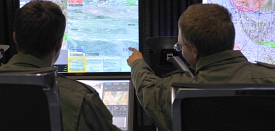Integrating Unmanned Aerial Systems (UASs) in busy airspaces is a key challenge for the future. This international ambition was brought closer to realization by linking an experimental ground station for unmanned aircraft to NLR’s Air Traffic Control Research Simulator (NARSIM). And this is just one of the many useful applications of the Multi Unmanned Aircraft Supervision Testbed (MUST), a system that the National Aerospace Laboratory of the Netherlands (NLR) and the German Aerospace Centre (DLR) began to develop over two years ago.To a certain extent, there is little left to improve in cockpits in manned aircraft, but this cannot be said of systems for the ground-based control of unmanned aircraft. MUST is a generic, modular and flexible system capable of testing communications between operators and unmanned aircraft, ranging from control commands and mission planning to the properly timed activation of sensors.
Unmanned aircraft are being deployed for an increasingly wide range of tasks. The rapid increase in their autonomy allows them to perform a growing variety of tasks without human intervention. In addition, the so-called ‘situational awareness’ of ground-based operators is taking on an increasingly important role. Such situations might range from the collection of military intelligence by large robot aircraft flying at high altitudes (such as the Global Hawk) to the detection forest fires or the inspection of oil pipelines by small aerial vehicles (such as the Pelican quadrocopter). The MUST system facilitates research into all these aspects, regardless of the size of the unmanned aircraft or the nature of its tasks.
MUST also makes it possible to test the interaction between operators and other personnel involved. Thanks to its open architecture and functional diversity, the system has already been deployed in a wide range of large-scale experiments. In addition to being linked with NARSIM, MUST has also been integrated in Purple Nectar, a Dutch military exercise aimed at testing the usefulness of state-of-the-art ICT applications for the armed forces. MUST can also be linked with Fighter-4-Ship, a simulation facility developed by NLR that allows fighter pilots to train complex scenarios. In all these exercises, large parts of the scenarios could be simulated as required, supplemented by real equipment and personnel.
The applications of MUST are not limited to the development and testing of experimental technologies and procedures. NLR can also make good use of the knowledge thus gained to support the Dutch Ministry of Defence in selecting unmanned systems.
The development of the MUST system is part of AT-One, a strategic ATM (Air Traffic Management) research alliance between NLR and DLR.
Also visit our UAS Human Effectiveness capability page.


